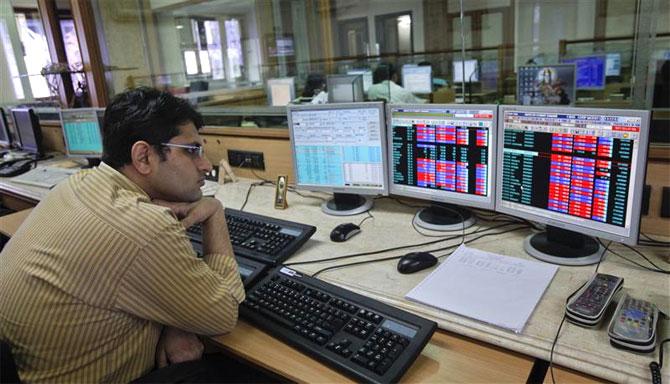Photographs: Ajay Verma/Reuters Shine Jacob in New Delhi
India Inc is more confident about a revival in general economic growth, as well as performance of its own companies, in the third quarter of the current financial year, shows a survey conducted by the Confederation of Indian Industry.
However, the respondents were also concerned about political and economic instability, with the Lok Sabha polls four to five months away, and at corruption, slackening of consumer demand, high inflation and foreign exchange volatility.
The survey is based on responses from 174 industry members.
About 63 per cent belong to large-scale firms, 12 per cent are from medium-scale firms and 25 per cent from small-scale ones.
About 65 per cent were from the manufacturing sector and 35 per cent from services.
. . .
Why India Inc is confident of an economic revival
Image: Labourers work at the construction site of an educational institute in Gujarat.Photographs: Amit Dave/Reuters
| INDUSTRY’S ECONOMIC FORECAST |
|
The CII confidence index, part of its Business Outlook Survey, rose to the highest level in six quarters at 54.9 points in October-December of 2013-14.
In the previous quarter, it was below the psychological level of 50 points.
In the same quarter of 2012-13, it was at 49.9.
. . .
Why India Inc is confident of an economic revival
Photographs: Reuters

It showed 58 per cent of respondents expected an increase in their sales in the third quarter, much higher than the 45 per cent in the previous quarter. On input cost in the current quarter, a majority also expected it to increase.
Against this backdrop of improvement in sales , 43 per cent were hopeful about an increase in their pre-tax profit margin in the quarter, much higher than the 31 per cent in the previous quarter. Another positive signal was that an improvement in capacity utilisation was expected.
As compared to 56 per cent of respondents experiencing less than 75 per capacity utilisation in the second quarter, only 45 per cent said utilisation would fall below 75 per cent in the third quarter.
. . .
Why India Inc is confident of an economic revival
Photographs: Reuters
About 53 per cent respondents expected their exports to increase in the current quarter, against 49 per cent in the previous one.
About 42 per cent felt growth in gross domestic product in the current financial year would settle in the range of 4.5-5 per cent; 28 per cent expect 5-5.5 per cent.
The rate was below five per cent in second quarter of this financial year; for the first half of, it was 4.6 per cent. The government has said it expects a pick from the second half to register more than five per cent in 2013-14.
The largest proportion (41 per cent) of respondents pegged wholesale price index-based inflation at over seven per cent this year. Inflation rose to a 14-month high of 7.52 per cent in November against seven per cent in October.
. . .
Why India Inc is confident of an economic revival
Photographs: Reuters
Despite the fact that subsidies are likely to cross the budgeted target by a wide margin, and the impending Lok Sabha elections posing an upside risk to government expenditure, as much as 53 per cent of the respondents projected the Centre’s fiscal deficit to remain below five per cent of GDP, broadly in line with the government’s target.
The Union Budget estimated the deficit at 4.8 per cent of GDP for 2013-14, compared to 4.9 per cent in the previous year.
The deficit till October had touched a little over 84 per cent of the budget estimates for the entire year till March-end.
Though the current account deficit moderated sharply to 1.2 per cent of GDP in the second quarter from 4.9 per cent in the first, the figures might be higher for the entire year.
Around 63 per cent of respondents forecast it would settle in a range of 3.5-5 per cent of GDP this year; only seven per cent felt it would fall below 3.5 per cent.
The CAD was at an all-time high of 4.8 per cent of GDP in 2012-13.
. . .
Why India Inc is confident of an economic revival
Image: A vendor hangs a lantern for sale at a Diwali market in Mumbai.Photographs: Danish Siddiqui/Reuters
“With some positive signals from the global economy, which finds a resonance in our improved export performance and is causing our CAD to decline, we believe the slowdown in the domestic economy might have bottomed out in the second quarter and the trend could reverse henceforth,” said CII director general Chandrajit Banerjee.
There are risks to the economy as well, perceived by respondents.
These relate to economic-political instability, low consumer demand, corruption, high inflation and volatility in foreign exchange rates.
As many as 55 per cent expected the exchange rate to remain in the range of Rs 61-63 a dollar by March. The rupee closed at 61.85 against a dollar on Friday.
The survey is based on the responses from over 174 industry members.
Majority of the respondents (63%) belong to large-scale firms, while 12% are from medium-scale firms and 25% from small-scale.
Further, 65% of the respondents are from manufacturing sector and 35% from services.







article